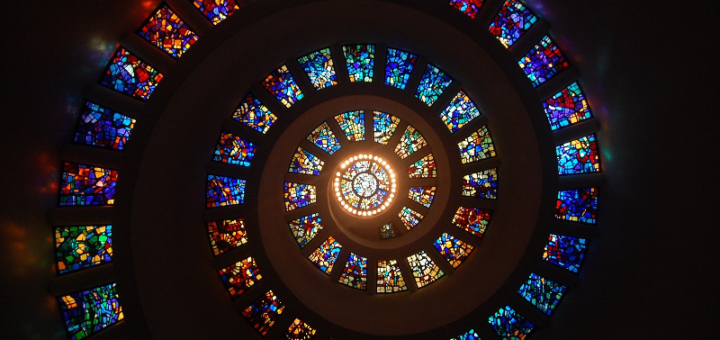
 Image credit: Pixabay.com (2000), CC0/PD[/caption]
Fans of Heath Ledger will recognize this phrase from one of my favorite films, A Knight’s Tale. In the film, Jocelyn, one of the main characters, comments that she comes to cathedrals for two reasons: Confession and the glass. The glass, as she so eloquently puts it, is “a riot of color in a dreary gray world.”
I have always loved this line. How accurate, insightful and Catholic! Stained glass has always had a multitude of purposes. Practically speaking, it’s a window, meant to let in light and keep out the wind. The glass often tells a story. The earliest stained glass were designed as instructional tools to help a mostly illiterate population learn the stories of the Bible and saints. As history and architecture advanced, the word “multipurpose” hardly does justice to all these windows were capable of.
Image credit: Pixabay.com (2000), CC0/PD[/caption]
Fans of Heath Ledger will recognize this phrase from one of my favorite films, A Knight’s Tale. In the film, Jocelyn, one of the main characters, comments that she comes to cathedrals for two reasons: Confession and the glass. The glass, as she so eloquently puts it, is “a riot of color in a dreary gray world.”
I have always loved this line. How accurate, insightful and Catholic! Stained glass has always had a multitude of purposes. Practically speaking, it’s a window, meant to let in light and keep out the wind. The glass often tells a story. The earliest stained glass were designed as instructional tools to help a mostly illiterate population learn the stories of the Bible and saints. As history and architecture advanced, the word “multipurpose” hardly does justice to all these windows were capable of.
- The windows reinforced the reality that within a cathedral heaven and earth meet during the Mass.
- Often, there was a very specific order and placement of the windows which served to underscore their depictions. For example, most churches face east in anticipation of the rising sun and the Second Coming of Christ. The windows on the eastern wall would then portray scenes from the Resurrection and heaven itself. Along the north wall stood scenes from the Old Testament, which was associated with cold and darkness, the time before Christ. The south wall held the New Testament scenes. The west wall would have displayed scenes from the Last Judgment or the Fall in the Garden, scenes which reminded people they were passing from this earthly reality into a new, heavenly one.
 Image credit: Pixabay.com (2015), CC0/PD[/caption]
Image credit: Pixabay.com (2015), CC0/PD[/caption]
- The windows let in light, but a filtered, colored and somewhat dimmer light. This is no accident. As architecture progressed, one of the focuses was to find a way to have bigger, more impressive open spaces for windows. The larger the window, the grander the glass but interestingly, not necessarily an increase in bright light:
Although Gothic windows opened up walls of light within the cathedral, the effect was not as much to illuminate the interior as to create an atmosphere of physical and spiritual beauty: “stained glass prevents much of the natural light from entering [providing instead] colored and changing light in the windows themselves and flickering light over the stone interior. (Carol Ann Jones on SacredArchitecture.org)This effect is called the Purkinje shift or “twilight vision.” After spending about a half hour in one of these Gothic cathedrals (Chartres, for example) your color sensitivity heightens, as if you’ve been transported to a new visual plane. The windows are Beautiful, and I do mean with a capital B. Bishop Robert Barron, and through him the 20th Century theologian Hans Urs von Balthasar, speaks often of the three great paths to God: the Good, the True and the Beautiful. Both Barron and Balthasar advocate that starting with the Beautiful is the most effective first step in helping others come to know God. What is the Beautiful? Stained glass is an exquisite example. There are 3 characteristics of the Beautiful: wholeness, harmony and radiance. The glass, especially a series of windows, illustrates the reality of the world in its fullness or wholeness. We learn what the world was designed to be and are inspired by the lives and stories of those who worked to make it a reality. The glass works in harmony with the building, other windows and within the individual window itself. There is a harmony of color and of light. We learn who we are and how we ought to be in relationship with each other and with God. Finally, the windows are radiant. Rather than simply letting light pass through them, the light brings to life each intricate detail and element. When we let the light of Christ shine through us, every intricate detail of our being is used to highlight His glory.
 Image credit: Pixabay.com (2018), CC0/PD[/caption]
The next time you have the opportunity to view stained glass, slow down and take your time to savor this unique art form. Through their luminosity, depth, and color they can connect you to the deeper spirituality present all around you.
Image credit: Pixabay.com (2018), CC0/PD[/caption]
The next time you have the opportunity to view stained glass, slow down and take your time to savor this unique art form. Through their luminosity, depth, and color they can connect you to the deeper spirituality present all around you.
Copyright 2020 Kate Taliaferro
About the Author

Kate Taliaferro
Kate Taliaferro is an Air Force wife and mom of 6. She has a Masters in Religious Education and tries to find God's presence in all parts of her day, be it cooking, cleaning or just the everyday ordinary. She enjoys homeschooling, stitching crafts and finding cheerios between the couch cushions. She blogs at Daily Graces.


.png?width=1806&height=731&name=CatholicMom_hcfm_logo1_pos_871c_2728c%20(002).png)
Comments